The Ins & Outs
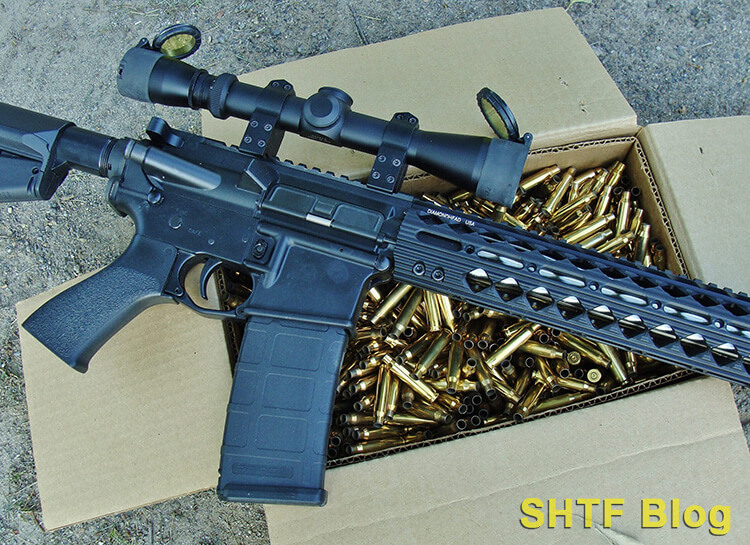
Final yr I posted an article overlaying the creation of .300 Blackout cartridges from fired .223/5.56 NATO brass. However l might have put the cart earlier than the horse. Figuring out the best way to reload 5.56 brass might be step one. The Blackout nonetheless has robust curiosity, and it fills a helpful area of interest, however gross sales of .223 Remington/5.56 NATO ammunition nonetheless outpace it by an enormous margin.
AR-15 gross sales stay brisk as properly. The platform has advanced to embody numerous fascinating calibers, however most are nonetheless chambered to fireside the ever present “5.56.” So, placing two and two collectively, many AR homeowners should be sitting on copious collections of fired circumstances. And in the event that they occur to be brass boxer-primed variations, they symbolize a supply of renewable ammunition.
However for these with no reloading expertise, studying the best way to reload 5.56 brass could be a problem. The logical start line is information, a primary understanding of the method. That’s the important thing to procurement of different the necessities; gear and elements. Proper off the bat although, I’ll simply say you received’t get the complete low-down from a brief article like this one.
Reloading isn’t rocket science, however the superb factors must be understood. Which takes us again to the above paragraph.
.223 vs 5.56 – What’s the Distinction?
Dimensionally, there’s no actual exterior distinction between a .223 Remington and 5.56 x 45 NATO cartridge; the truth is, the latter is simply an offshoot tweaked for navy use by way of a stress enhance. That enhance offered the slight velocity achieve wanted to fulfill NATO’s vary and penetration requirements. Nevertheless, a little bit of further chamber size was required to present the bullets a protected operating begin.
As a result of a regular .223 Remington chamber lacks this extra clearance, a change to hotter 5.56 NATO rounds may end in unsafe pressures. No worries in reverse although; you may safely fireplace .223 cartridges by means of a 5.56 NATO chamber. FYI, a “Wylde” chamber is designed to securely fireplace both load, typically with wonderful accuracy.
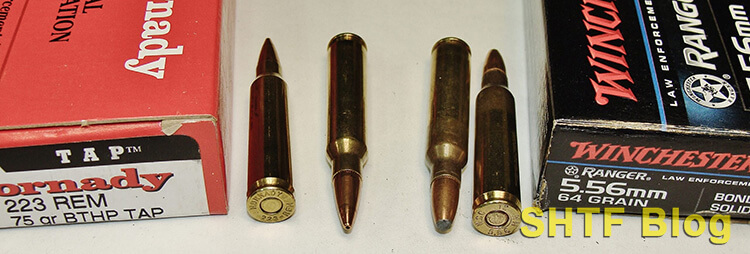
A attainable subject for reloaders: navy brass can run a tad thicker, leading to a minor capability lower. Thus, some in any other case protected .223 powder costs may elevate pressures in 5.56 circumstances – one purpose (of a number of) why reloaders ought to by no means start with “most” masses. As a substitute, we work our means up whereas waiting for indicators of extreme pressures – a subject onto itself.
Why Brass Instances?
Numerous supplies have been used to create cartridge circumstances to incorporate polymers, aluminum, metal, and brass. However brass has all the time been an excellent metallic cartridge selection due to its malleability. When fired the cartridge case should broaden towards the chamber partitions to forestall harmful stress escapes – and it should additionally contract to permit extraction.
For all the above supplies – besides brass – this course of is a one-shot deal. However due to its elasticity, a brass case might be safely “resized” to its authentic dimensions for a number of loadings. Metal-cased ammo is often extra reasonably priced, but it surely received’t work. When you’re considering rolling your individual cartridges, you’ll want brass circumstances.
Boxer Primed?
The overwhelming majority of American centerfire cartridges are boxer-primed, whereas the Berdan system is extra frequent in Europe. The latter can be reloaded, however the course of is rather more sophisticated. Fortuitously, it’s simple to inform them aside by means of a peek inside a fired case. A Berdan-primed case has two small opposing holes in its base.
A boxer-primed case has one central flash-hole, which means it fired primer might be popped free by way of a “decapping pin” – a comparatively easy course of. U.S. reloading gear is designed for these circumstances, however military-type 5.56 brass wants an additional step. Because of the rigors of full and semi-auto feeding the primers are “crimped” in place.
When the fired primer is eliminated a small annular lip will stay which should be eradicated previous to repriming. It’s a simple chore to carry out with the precise gear, but it surely provides an additional step to case preparation.
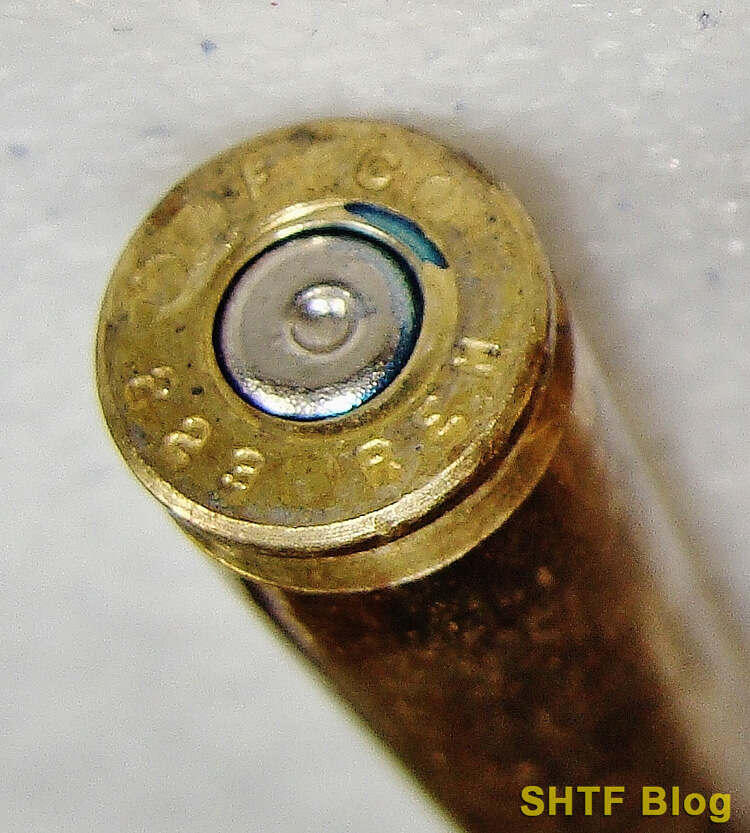
Reload 5.56
Assuming you have got an appropriate provide of brass, the logical first step is base-level information. One good supply has all the time been the reloading manuals offered by main part producers. Most record caliber-specific masses for a big number of in style cartridges, and plenty of additionally embody helpful “the best way to” chapters.
As for elements, the probabilities for many calibers are daunting, and crusing into uncharted waters is a recipe for catastrophe. However by sticking to the manuals, the recipes will probably be confirmed by means of empirical velocity and stress checks. Nevertheless, by their nature, these publications are extra generic. Toss .223/5.56 into the identical combine as a gas-operated semiautomatic just like the AR-15 and system-specific issues will come up. Fortuitously, Lyman has addressed them by means of their newest AR Reloading Handbook.

Lyman AR Reloading Handbook 2nd Version
- Reloading handbook devoted to the Fashionable Sporting Rifle;Reloading information for almost all AR based mostly calibers;Specialty articles written by in style writers;Information makes use of all in style manufacturers of bullets and powders;Consists of solid bullet information and sub-sonic load
It’s a fantastic start line for anybody considering the reloading of 5.56, in addition to different AR-15 based mostly calibers.
The Reloading Course of
Reloading begins by resizing a fired cartridge case to its authentic dimensions. De-priming follows, sometimes carried out by the resizing die. Subsequent comes the seating of a brand new primer, adopted by a cost of powder. The ultimate step is bullet-seating. End result: A useable cartridge of a specified general size that ought to operate in a magazine-fed firearm.
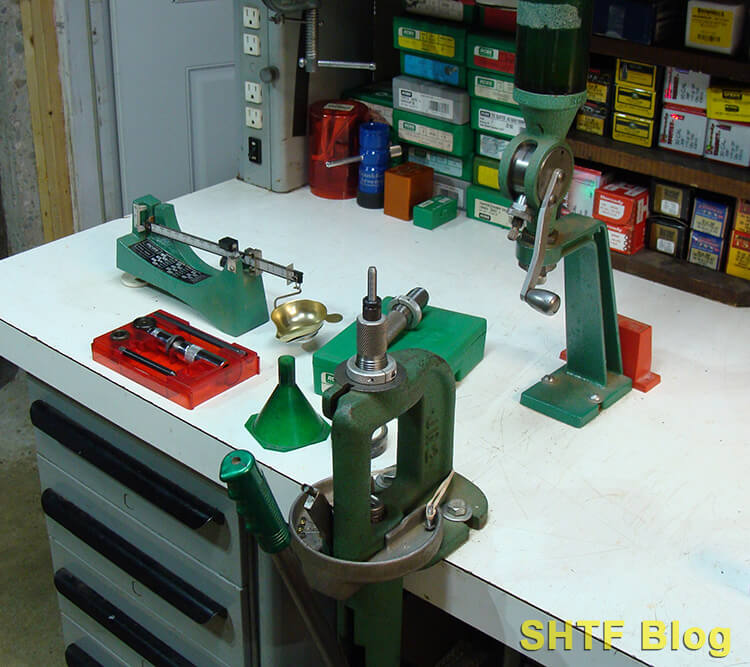
Obligatory Tools
The principle objects embody a reloading press, shell-holder, a set of caliber-specific dies, and a scale to weigh the powder costs. Relating to dies, an upcoming put up will cowl reloading .30-06 cartridges with a easy Lee Loader package, which partially resizes circumstances (by way of neck-sizing). However dependable operate of 5.56 reloads in semi-autos calls for the usage of a full-length resizing die and the mechanical leverage of a press.
The excellent news is, most include priming programs, they usually’re threaded to simply accept all commonplace dies. The presses’ ram wants the precise shell-holder to know the cartridge circumstances, but it surely’s a cheap half. A way to trim circumstances may even be required. Extra on that shortly.
Elements
As a result of a cartridge case is the most costly part, reloads can supply price financial savings. This leaves primers, powder, and bullets. However one measurement received’t match all. Every should be suitable with the caliber and chosen load – the rationale we want a guide!
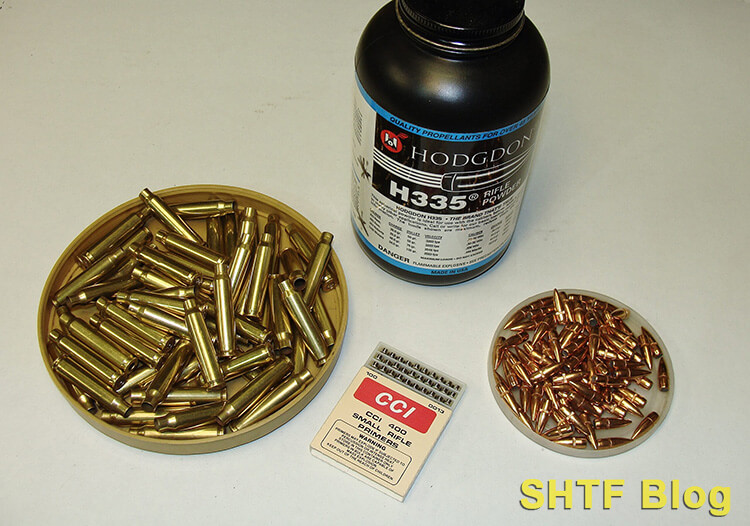
Steps
Most bottle-necked cartridges – like .223/5.56 – are reloaded with a set of two dies. The primary die resizes the fired case whereas concurrently expelling its primer. The second die seats the projectile. Most may also be adjusted to use a bullet-gripping crimp to the case mouth.
Truly, each dies should be correctly adjusted, however the course of is fairly straight-forward, and instructions accompany every set. Assuming that’s already occurred, let’s undergo the steps.
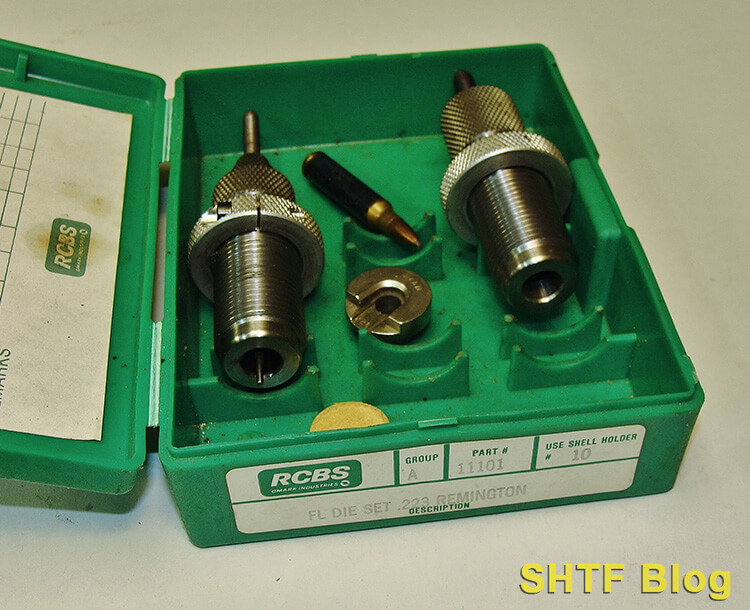
Resizing & De-priming
The resizing die is spun into the press, and the shell holder is snapped into its ram. Then a small dab of case-lube is utilized to every case to forestall it from sticking within the die. Subsequent, a case is pushed into the resizing die by means of the leverage of the press. On the similar time, a pin within the middle of the die enters the flash-hole to expel the fired primer.
Primer Seating
A number of strategies exist right here. A brand new primer may very well be seated by way of a pivoting arm constructed into most presses. Different choices embody hand-held priming devices and separate priming presses.
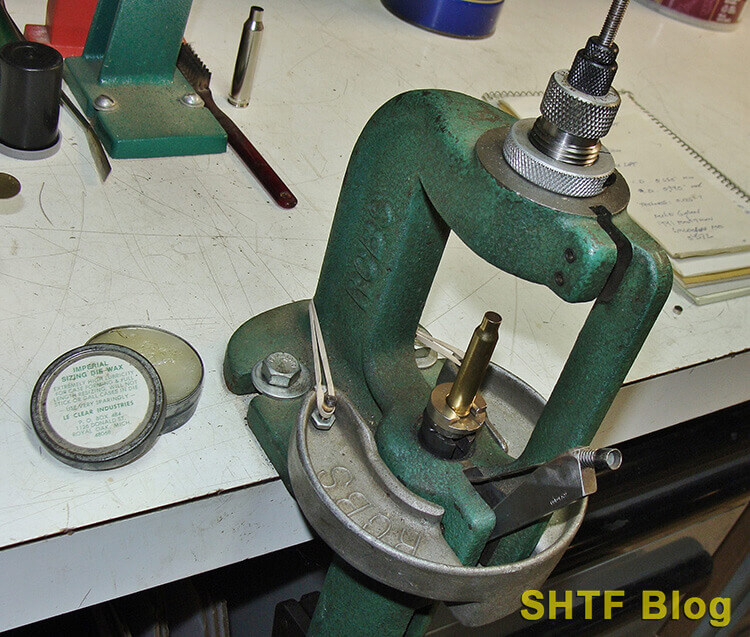
Propellant
For security’s sake, costs are listed by weight in “grains” – which makes a powder scale important. Every particular person cost may be weighed and distributed with a funnel, however that takes time. The faster mass-production different is an adjustable powder measure, set to dispense a weight-calibrated cost by means of every throw of its deal with.
Bullet Seating
Switching to the seater die, a primed and charged case is slipped into the shell holder. A bullet is then fastidiously aligned with its mouth to assist information the bullet into the die. As its tip makes contact with the die’s seater-plug, seating commences. Changes to its threaded stem management the seating depth.
As famous above, the die itself might be adjusted to use a crimp by way of its inside shoulder (extra on this shortly).
Reloading .223 vs 5.56 NATO
I’ve been loading .223 and 5.56 from a set of RCBS .223 Remington dies for a number of a long time and intend to stay with ‘em. Early on, most reloads they produced have been destined for .223 bolt-action varmint rifles. In concept at the very least, tighter .223 chambers have the potential to yield higher accuracy than 5.56 NATO variations attributable to a bit much less slop – perhaps.
The .223 Remington Aspect
I personal a few Dillon high-volume progressive presses, however all of my .223 handloads are assembled on an RCBS single-stage press with TLC. End result: 5-shot teams which have constantly produced half-moa teams from numerous correct rifles over time. A lot of the brass comes from Federal American Eagle .223 “Q-loads”, fired in massive portions throughout my company’s AR-15 vary classes.
The circumstances get a great cleansing, however that’s about it. I’m not overly hung up on the model so long as the headstamps are the identical – and I do know the historical past of the circumstances. Consistency being essential, I load in batches which have undergone the identical variety of firings, starting with once-fired brass. Civilian/sporting .223 circumstances get rid of crimped primer-pocket hassles (often). However security and consistency nonetheless require trimming to a specified size.
Because it seems, the identical reloads operate and shoot properly by means of a number of AR-15s with Wylde and 5.56 NATO chambers. However, if ranging from scratch with the intent of loading for an AR, I’d go a unique route.
5.56 x 45 NATO Nuances
Semiautomatic rifles lack the intrinsic camming energy of a bolt-actions and as famous above, the ammunition will get a rougher trip. Bullets impression feed-ramp throughout their transit to the chamber and, as fouling takes its toll, stoppages can happen.
Fortuitously, Lyman has addressed these issues although the right complement to their AR-15 Handbook; the MSR Precision Die System. Not like commonplace two-die units, it ships with a 3rd die and a cartridge gauge, engineered to enhance operate within the AR system (it comes with a shell holder, too).
The total-length sizer remains to be there, but it surely’s a “small-base” model. This design has been round some time. It provides every case a bit of additional squeeze to make sure dependable semiauto chambering.
The seating die is just like others however, as a result of it lacks a crimping shoulder, it’s solely operate is bullet seating. Elimination of the shoulder prevents the attainable collapse of a cartridge’s shoulder throughout efforts to use a decent “roll crimp”.
A further crimping die offers the neck rigidity required to grip bullets throughout their bumpy journey by means of an AR’s motion. As a substitute of utilizing a shoulder, rigidity is regularly utilized by means of a taper-crimp.
The fourth merchandise is a go/no-go case-gauge – nice insurance coverage towards stoppages! The gauge is machined for a 5.56 “chamber.” If a loaded spherical drops in flush, it’s a “go.” If not, it’s a reject – a complete lot simpler to clear from the gauge!
So long as high quality elements are used, there’s no actual purpose to count on an considerable accuracy loss with such a system. The truth is, with some combos, you might even see none in any respect regardless of the 5.56 NATO chamber – assuming you start with first rate brass.
Case Prep Counts
Once more, it’s greatest to begin with clear circumstances. They don’t must be spotless, however they need to be freed from die damaging grit. I batch-clean mine in a vibratory case tumbler they usually come out wanting minty.
Primer Pocket Prep
Removing of primer pocket crimps is a one-time chore. Of the a number of strategies accessible on my bench the one I exploit essentially the most is Dillon’s Tremendous Swage. It’s sorta like a horizontal press and has the leverage to iron out the annoying brass lips in a single clean stroke.
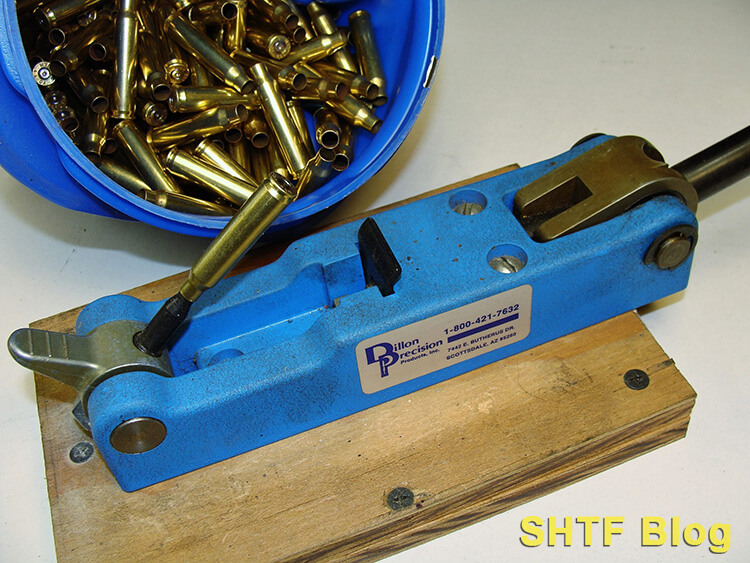
Case Trimming
Instances “develop” by means of a number of firings, to the purpose the place they’ll attain unsafe lengths (clearance is required for launch of the bullet). And, since constant crimps are contingent on circumstances of a uniform size, they need to be trimmed previous to their first reload.
Of the a number of strategies available I’ve one other a favourite: Little Crow Gun Works sells a cutter/pilot system designed to be spun in a drill. It resembles an oversize chuck, works nice when hand-feeding circumstances, and saves a lot of time.
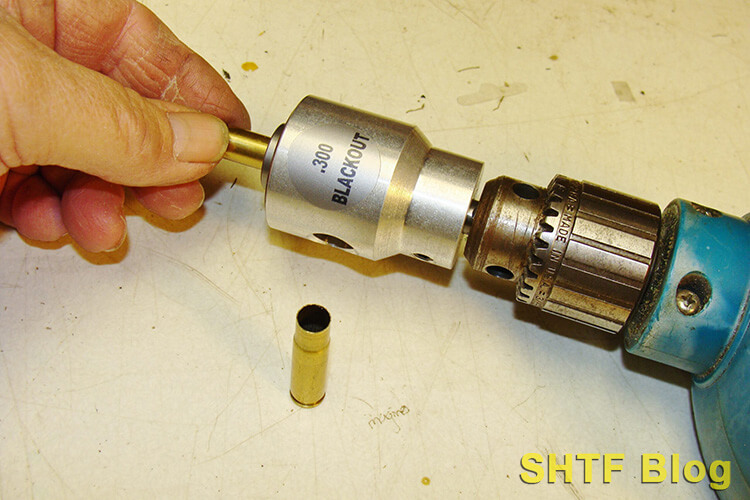
Different Objects
As soon as the circumstances are trimmed, they’ll must be de-burred for clean bullet seating. I clear my primer pockets after every firing; others don’t. Cheap hand-tools can deal with these chores, or you may go all-in for an electrical case-prep middle. Currently, I’ve been utilizing an in-between multi-station unit offered by Hornady.
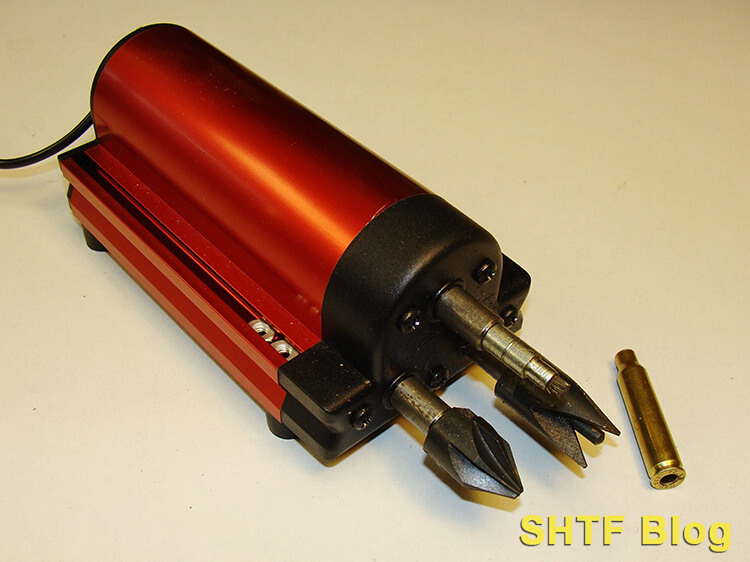

Hornady 050160 Lock-N-Load Case Prep Trio
- Hornady Case Prep Trio – The Hornady Lock-N-Load Case Prep Trio helps to make case prep quicker and simpler with out taking on precious actual property in your reloading bench
- Save Area and Time – Pace up your case prep course of and make the most of the onboard storage for different 8-32 thread instruments. The three-Software capability saves time by having all essential instruments mounted and able to use. You may chamfer, deburr and clear primer pockets with out having to vary instruments
One essential merchandise for all is an correct means to find out case and general cartridge size. The device for these jobs is a caliper, able to offering measurements in thousandth-of-an-inch. After all, a scale is one other important. A powder dispenser isn’t, but it surely certain will velocity up the reloading course of – as will cartridge trays and a rabbit gap of different helpful objects.
After which there’s elements. What to purchase? That’s the place the guide is available in. Plenty of load choices translate to extra part selections – price figuring out in a decent market. Add the precise dies and also you’ll have the makings of an ammunition manufacturing unit.
Abstract
Is reloading actually price it? The reply actually boils right down to funds, house, and time. Till just lately, manufacturing unit 5.56 ammunition has been fairly reasonably priced. However recently costs are creeping upward.
I doubt this case will enhance anytime quickly, based mostly on dependable info regarding producer backorders. Because of this, I do my greatest to take care of a stash of excellent brass. It’s not solely good insurance coverage; seems the identical circumstances may preserve a .300 Blackout operating.
